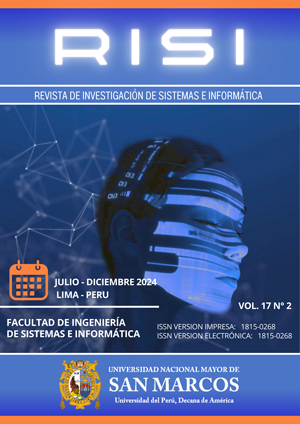Evaluating Algorithms for Predicting Academic Performance of Students with Disabilities
DOI:
https://doi.org/10.15381/risi.v17i2.29736Keywords:
prediction of academic performance, students with disabilities, educational inclusion, learning automatic, SVM, Logistic RegressionAbstract
This study analyzed the opportunities for predicting the academic performance of university students with disabilities through the use of machine learning algorithms. In the context of Information and Communication Technologies (ICT) as an essential tool for educational inclusion, the research aims to develop a reliable predictive model to optimize academic performance and reduce student dropout rates. The study is based on data from students at the National University of San Marcos (2019–2023), evaluating sociodemographic, academic, and contextual variables. Models such as Support Vector Machine (SVM), Logistic Regression, Decision Trees, among others, were implemented, using metrics such as precision, sensitivity, F1-Score, and AUC for evaluation. The findings highlight SVM as the most accurate model (AUC of 0.9839), followed by Logistic Regression, known for its balance between accuracy and interpretability. Although Random Forest and Neural Networks also showed good results, KNN presented significant limitations. The study concludes that predictive models are fundamental tools for identifying students at risk and developing personalized strategies that promote inclusion. Furthermore, it is recommended to explore advanced techniques such as deep learning and extend the implementation of these models to diverse educational settings.
Downloads
Downloads
Published
Issue
Section
License
Copyright (c) 2024 Sara Esther Cañari De la Cruz, Ciro Rodríguez Rodríguez

This work is licensed under a Creative Commons Attribution 4.0 International License.
AUTHORS RETAIN THEIR RIGHTS:
a. Authors retain their trade mark rights and patent, and also on any process or procedure described in the article.
b. Authors retain their right to share, copy, distribute, perform and publicly communicate their article (eg, to place their article in an institutional repository or publish it in a book), with an acknowledgment of its initial publication in the Revista de investigación de Sistemas e Informática.
c. Authors retain theirs right to make a subsequent publication of their work, to use the article or any part thereof (eg a compilation of his papers, lecture notes, thesis, or a book), always indicating its initial publication in the Revista de investigación de Sistemas e Informática (the originator of the work, journal, volume, number and date).


